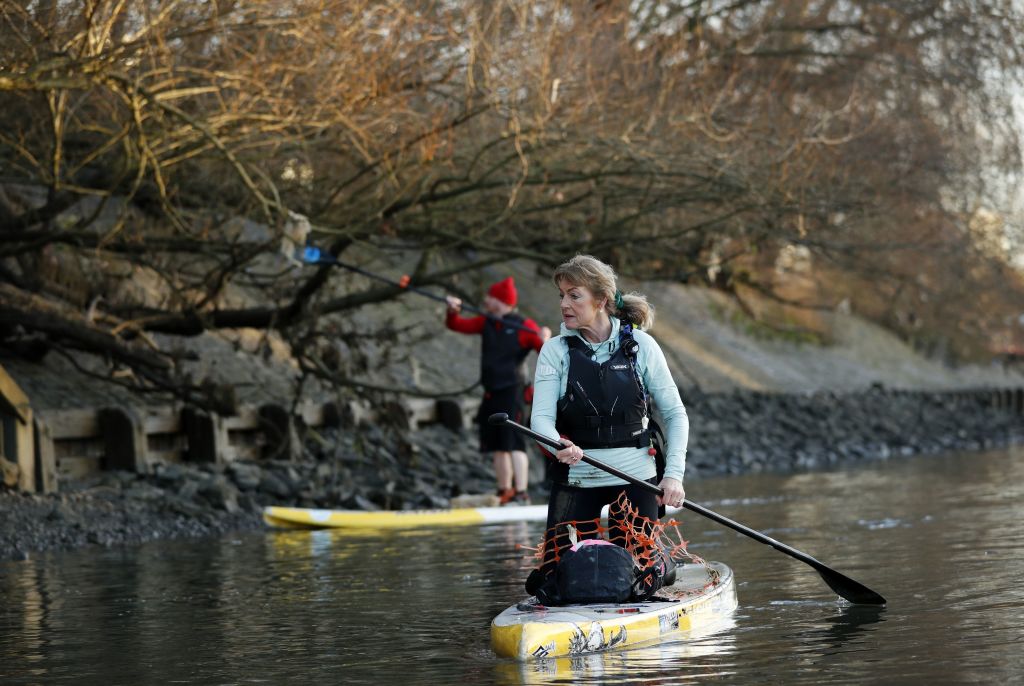Cold water swimming has gone from an eccentric and very niche pursuit to something everyone is doing – and is very keen to tell you about, whether or not you’re interested. There’s been a bit of a backlash against the sport’s popularity recently, with a variety of objections. The first comes from the ‘in my day, we called it swimming’ brigade, who are particularly aerated about the current fashionable term ‘wild swimming’. It’s just swimming, they say, and people who do it aren’t any more special than anyone else. The second is the one that accompanies every new trend: it’s being colonised by annoying middle class types who are turning what is by its very nature a low cost, wild, activity into something you need expensive kit to do (see this piece on the ‘Dryrobe wankers’ of Dublin, for instance). In some places, the backlash – backsplash? – has taken on a darker side: a group of swimmers in the Lakes have found the tyres of their cars slashed by someone who apparently objects to them parking and swimming in Windermere.
For those of us who got into the cold water before the idea became so hot, it’s largely heartening to see so many people joining in. There is a good and growing body of research suggesting that cold water swimming (as opposed to splashing about in a warm chlorinated soup) can help people with certain mental illnesses manage their condition. There are downsides of anything enjoying a moment of massive popularity, of course: some winter swimming spots in London have been dealing with a surge in hypothermia cases in the past few years as inexperienced swimmers stay in for far too long, and, yes, there are dilettantes who pop up with fancy kit and Instagram hashtags before drifting with the current on to the next trend.
The most positive thing about the trend for swimming outdoors is that it’s starting to have a ripple effect on our environment
But the most positive thing about the trend for swimming outdoors is that it’s starting to have a ripple effect on our environment. Take the River Wharfe in Yorkshire, announced as the first river in England to become a designated bathing site. This means the Environment Agency will monitor pollution levels in the water to ensure it is safe for swimmers, following a campaign by a group of bathers who had grown concerned that sewage was regularly being discharged into an increasingly popular swimming spot.
Swimmers aren’t the only ones who will benefit from cleaner rivers. England’s watercourses are in a dreadful state, with just 14 per cent rated of good ecological standard this year. This means that very few of them indeed are good enough for flora and fauna to thrive, which goes some way to explaining why the UK is one of the most nature-depleted countries in Europe.
One of the reasons biodiversity across the UK is so poor is that we have largely lost our cultural connection to nature, with words for birds and flowers dropping out of children’s dictionaries to reflect their dwindling use, and British children having less outdoor time on average than prisoners. We do not spend enough time outside to notice how poor the environment is, and we do not really know what is natural and what isn’t any more. That’s one of the reasons people resort to calling it ‘wild’ swimming: it is so very different to the experience that most of us had of what we ‘just called swimming’ in indoor pools with lanes and chemicals and floating plasters.
Wharfe River isn’t the only one with a campaign group of swimmers who’ve seen what water companies discharging sewage and the run-off from intensive agriculture can do to wild water. In the Thames, there’s the London Waterkeeper campaign for proper monitoring of sewage outflows and of the water quality, with a long-term view to making one of the world’s most famous rivers viable to swim in like those in other European cities such as Bern. The Thames has improved a great deal in the past few decades but swimmers still come across sewage in the water on a regular basis and as a result it is not advisable to swim in the river after heavy rain.
The number of swimmers on the Thames has soared over the past couple of years too, and with that increase popularity will come more pressure to improve the water. Some of them will have joined because London swimming spots are increasingly hard to get into: the Hampstead Ponds are at the centre of a row about increased charges for swimmers, which campaigners argue are against the spirit of outdoor swimming. The Serpentine Swimming Club has had to close its membership list for the time being. People are looking elsewhere – and discovering quite how poorly we have been looking after our rivers. Hopefully the legacy of this popularity will be rivers teeming with fish and fowl and flowers, which will last far longer than the ‘dryrobe wankers’.







Comments